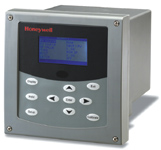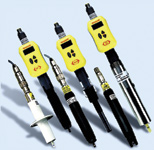Leading-edge sensor suppliers are embracing a modular approach to sensor design. This methodology allows suppliers to use both their design and their manufacturing capabilities for markets where the use of several sensors is common. Customers benefit from both the flexibility and the cost savings that this approach provides.
In the broad context, modular sensors are product designs that can interchange a variety of different attributes including but not limited to different sensors, e.g., pressure and pH, sensor ranges, and packaging configurations. The benefit of the modular approach is cost savings. In many cases they occur immediately, and they tend to continue over time.
Electrochemical sensors for industrial applications are particularly well suited to the modular approach. Typical sensors for industrial process control measure contacting conductivity, pH, dissolved oxygen, and oxidation-reduction potential (ORP). Common applications of these sensors include wastewater control (especially for dissolved oxygen), water quality, boiler applications, utilities, and pharmaceutical manufacturing.
The typical mounting technique for industrial sensors uses a probe or electrode as the physical housing for the sensor that interfaces to the process. This type of assembly lends itself to a modular approach. The probes provide a millivolt or current signal to either a locally mounted instrument or a remote panel in a control room. The modularity concept can best be described at the instrument level. Two product types provide examples of available modular sensors.
Modular Analyzer Platform
The first example, the UDA2182 analyzer (see Figure 1), is Honeywell's most sophisticated approach to modular sensing. The analyzer provides a basic platform for the measurement of various process control parameters, where the user determines the configuration required for specific measurements and, based on the modular approach and the help of the analyzer, reconfigures the unit for different sensor measurements. The UDA2182 has single or dual input for pH, ORP, contacting conductivity, or dissolved oxygen, and accepts a dual input in any combination of measurements.
 Figure 1. The UDA2182 dual-input analyzer provides a platform for modular sensing. Sensors include contacting conductivity, pH, dissolved oxygen, and oxidation-reduction potential. |
The basic UDA2182 has a CPU card and power supply card—common elements that are required for acquiring sensor signals. Input cards for a specific sensor measurement are easily installed or changed depending on the desired measurement. The dual-input measurement system allows two simultaneous measurements, eliminating the need for a dedicated instrument for each sensor.
Factory precalibration of the input cards for the different types of measurement simplifies their installation. The user simply plugs in the desired card for the particular measurement as needed (see Figure 2). The instrument detects the type of card, e.g., a pH card, so it has all the information required to take the pH measurement automatically loaded to the instrument. This includes the menu and setup structure that are automatically set in the instrument. The pH sensor must be connected to a pH board for proper operation, but the mating of the proper sensor to its counterpart card makes it ready to operate—a modular match. It is an industrial sensing version of plug-and-play.
 Figure 2. These examples of typical information displayed on the UDA2182 are pH in Input 1 (A) and conductivity in Input 2 (B). |
The modular approach saves inventory cost for customers, an immediate up-front savings. With a basic unit and the appropriate input cards, the full range of four different measurements can be made without requiring a separate instrument for each measurement. Customers who must make at least two of the measurements—contacting conductivity, pH, dissolved oxygen, and/or ORP—immediately see the benefits of the modular approach. However, users needing only a single measurement can take advantage of the flexibility and ease of replacement.
Sensor-Specific Cards
The UDA2182 user readily appreciates the value of the modular approach by observing the changes that the analyzer makes for a particular measurement. Using a "plug in and recognize" approach, the analyzer provides only the pertinent information required for the user to set up the specific sensor type, reducing preparation time for the operator. Examples for pH, conductivity, and dissolved oxygen inputs demonstrate the differences.
The pH input accepts a wide variety of sensors including the nonglass Durafet and traditional glass electrodes, ORP electrodes, and the HPW7000 high-purity system. In addition to the basic unit, the pH input supports:
- 1. Auto buffer calibration
- 2. High-purity water solution compensation
- 3. Fast response rate (0.2 s update) for fast-responding pH electrodes
The conductivity input accepts signals from a standard selection of contacting conductivity cells. The conductivity unit also has:
- 1. Temperature compensation curves
- 2. Calculation of percent rejection/passage and difference of two cells
- 3. Conversions to parts per million, per billion, or per trillion total dissolved solids
- 4. USP 26 alarm capability
The dissolved oxygen input comes from a unique equilibrium probe, and the unit has three additional features:
- 1. Measurements in parts per million or per billion
- 2. Automatic or manual calibration
- 3. Ambient temperature and atmospheric pressure compensation
Process Instrument Explorer software enables the easy storage, modification, and retrieval of multiple instrument configurations. These configurations can be loaded into the UDA2182 through the IR port that is standard on all instruments. Front, hinged access to the analyzer simplifies the replacement of the input boards. Other features not necessarily associated with modular sensing add to the flexibility of the UDA2182, including the addition of relays or an analog output with a single board and the option to add a PID control. Packaging options for the sensor add the final element of flexibility and another level of modularity. Figure 3 shows the variety of packaging options for pH and ORP measurements.
 Figure 3. A variety of packaging options enhances the flexibility of the modular sensor approach. Those shown here are specificially for pH and conductivity measurements. |
The Direct Approach
The second example of modularity is a line of sensors in which the interfacing electronics mount directly on the sensor electrode or probe. These modular designs have a sensor interface module for each type and do not have the mix-and-match capability. For specific measurements, however, they provide a degree of modularity and flexibility. Figure 4 shows the modularity of the DirectLine approach.
 Figure 4. The yellow sensor electronics modules for pH, contacting conductivity, and dissolved oxygen all have the same form factor with a specific design for a single measurement. Different probes can attach either directly or remotely to the electronics. |
The electronics module mounts directly to the probe and provides a 4–20 mA output signal proportional to the measured variable. For safety and reliability during operation, the module locks securely into place. The DirectLine sensor module is approved for intrinsic safety in explosionproof environments. The unit integrates the keypad for operation, configuration, and calibration functions as well as the display in the weatherproof and corrosion-resistant enclosure. For electrode submersion or special mounting applications, the electronics module is also available in remote-mounting configurations.
The integral, yet separate, sensor plus electronics reduce wiring and cable runs, and panel cutouts make the units easy to install. The sensors' plug-in capability simplifies replacement and process control maintenance. Because the electronics for a DirectLine sensor are mounted on top of (or separate from) the probe, they can easily be installed on a replacement probe, avoiding the cost of replacing both portions.
A DirectLine sensor continuously performs prioritized self-diagnostics on both the electronics and the sensor, minimizing the time and expense of troubleshooting during start-ups, maintenance, and calibrations. A problem detected in either the module electronics or the sensor results in the software's ranking the problem type and the unit's displaying only the highest priority error to simplify the troubleshooting process. Correcting the diagnosed problem removes the error code from the display.
Modular Solutions
While customers have been asking for modular approaches to sensing for many years, satisfying their demands had to wait for cost reductions and technology advances in the electronics portion of the system. Honeywell's commitment to the industrial sensor and analyzer market is typified by its leading-edge technology in the field of modular sensing.
DirectLine and Durafet are registered trademarks of Honeywell.
Thomas Griffiths is Product Marketing Manager, Honeywell Process Solutions, Ft. Washington, PA; 215-641-3771, [email protected]. Additional information is available at http://honeywell.com/imc/ai/.